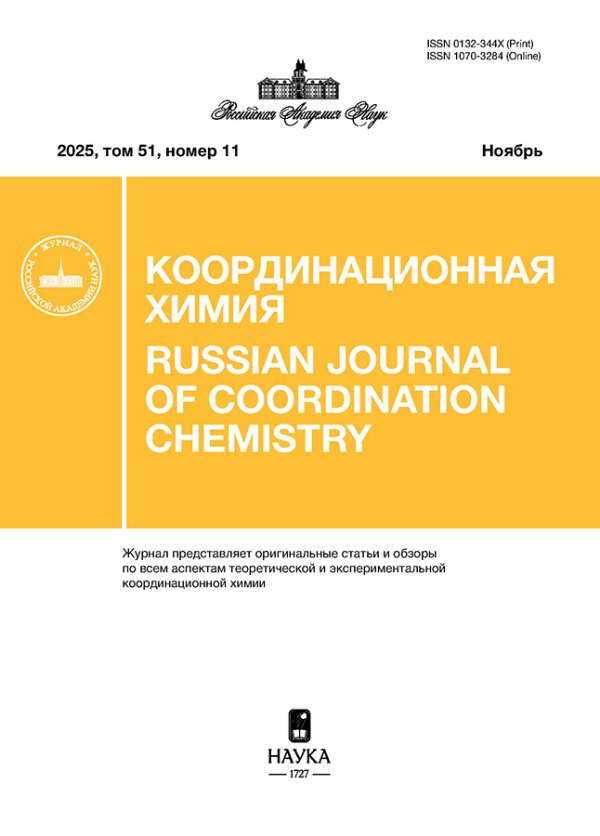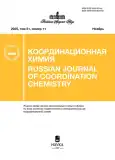Koordinacionnaâ himiâ
ISSN (print): 0132-344X
Media registration certificate: № 0110216 от 08.02.1993
Founders: Kurnakov Institute of General and Inorganic Chemistry of RAS, Russian Academy of Sciences
Editor-in-Chief: Eremenko Igor L., academician RAS, Doctor of Sc., Full Professor
Frequency / Access: 12 issues per year / Subscription
Included in: White list (2nd level), Higher Attestation Commission list, RISC
Current Issue
Vol 51, No 11 (2025)
Articles
Alkaline Earth Metal Bisamides Based on Unsymmetrical Acenaphthene-1,2-diimine
Abstract
Reduction of diimine ArMid-bian (L) (ArMid-bian = (1-[2,6-dibenzhydryl-4-methylphenyl]-2-[2,6-di-iso-propylphenyl]iminoacenaphthene) with excess magnesium, calcium, strontium or barium in the presence of catalytic amounts of the corresponding iodides leads to the formation of complexes [(ArMid-bian)Mg(Thf)(Dme)] (I), [(ArMid-bian)Ca(Dme)2] (II), [(ArMid-bian)Sr(Dme)2] (III) and [(ArMid-bian)Ba(Dme)2] (IV) containing the dianion ArMid-bian. Compounds L, I–IV were characterized by IR and NMR spectroscopy, as well as elemental analysis and single crystal X-ray analysis (CIF files CCDC 2440721 (L), 2440722 (I), 2440723 (II), 2440724 (III), 2440725 (IV)).
Koordinacionnaâ himiâ. 2025;51(11):673-685
 673-685
673-685


Oxovanadium(IV) Complexes with Pyridinedicarboxylate Anions and Terpyridine: Synthesis, Structure, and EPR Spectra
Abstract
The reactions of oxovanadium(IV) sulfate with potassium salts of 2,3-, 2,4-, 2,5-, 3,4-, and 3,5-pyridinedicarboxylic acids (PdcH2) and 2,2’:6’,2’’-terpyridine (Terpy) resulted in the formation of mononuclear heteroleptic complexes [VO(2,3-Pdc)(Terpy)] : 7H2O (I), [VO(2,4-Pdc)(Terpy)] : 5H2O (II), [VO(2,5-Pdc)(Terpy)] : 3H2O (III), [VO(3,4-Pdc)(Terpy)(H2O)] : 4H2O (IV), [VO(3,5-Pdc)(Terpy)(H2O)] : 7H2O (V) и [VO(3,5-PdcH)(Terpy)(H2O)](3,5-PdcH) : 2H2O (VI), respectively. The structures of compounds I–VI were determined by single-crystal X-ray diffraction (CCDC nos. 2326828 (I), 2326829 (II), 2326830 (III), 2326831 (IV), 2326832 (V), 2440463 (VI)). In the structures of I–III, the acid dianions act as chelating ligands via the pyridine N atom and the O atom of one carboxyl group, while in compounds IV–VI, the acid anion is coordinated in the monodentate fashion. In the crystal packing of compounds I–III, intermolecular π–π-interactions between the heteroatomatic moieties of N-donor ligands are present, while in complexes IV and V, the intermolecular π–π-interactions involve also the pyridyl rings of dicarboxylate anions. Polycrystalline samples and solutions of complexes III and IV were characterized by EPR spectroscopy.
Koordinacionnaâ himiâ. 2025;51(11):686-702
 686-702
686-702


First Example of Coordination Polymer Based on Tetrahedral Cluster Cyanocomplex of Rhenium and Barium
Abstract
In this work, the interaction of the anionic tetrahedral cluster complex of rhenium [Re4(AsO)4(CN)12]8– with Ba2+ was investigated. The reaction under hydrothermal conditions results in the formation of a framework coordination polymer [{Ba4(H2O)9}Re4(AsO)4(CN)12]·15H2O (I). The coordination polymer is formed from cluster anions [Re4(AsO)4(CN)12]8– and cationic fragments [{Ba4(H2O)9}8+, linked by CN– bridges. The resulting compound was characterized by single crystal X-ray diffraction (CCDC no. 2441985), PXRD, IR and elemental analysis.
Koordinacionnaâ himiâ. 2025;51(11):703-708
 703-708
703-708


A SIMPLE CATALYST FOR THE SYNTHESIS OF CYCLIC CARBONATES BASED ON ZINC(II) IODIDE
Abstract
A new zinc(II) complex, LZnI2, was obtained by the interaction of tridentate ligand 2,6-bis(5-(tert-butyl)-1H-pyrazol-3-yl)pyridine (L) with zinc(II) iodide. The compound was isolated in individual form and characterized using NMR spectroscopy and single-crystal X-ray diffraction (CIF file CCDC No. 2447394). The resulting complex exhibits catalytic activity in the reaction of CO2 with substituted epoxides to form cyclic carbonates. This behavior is attributed to the simultaneous presence of a Lewis acidic metal center capable of coordinating the epoxide, a Lewis basic nitrogen site facilitating CO2 binding, and a nucleophilic iodide anion that activates epoxide ring opening. The development of this approach to catalyst design may facilitate the creation of efficient systems for reactions of carbon dioxide with three-membered heterocycles.
Koordinacionnaâ himiâ. 2025;51(11):709-718
 709-718
709-718


Supramolecular Lanthanide Complexes with Cucurbituril: Luminescence and Logic Devices
Abstract
Complexes of the composition [{DyxLn2–x(H2O)5(NO3)}2CB[6]] (NO3)4 · HNO3 · 6H2O (x = 1, Ln = Eu; x = 0.8, Gd, Ho) (I–III) were obtained from a mixture of lanthanide nitrates and cucurbit[6]uril (C36H36N24O12, CB[6]) in nitric acid upon heating at 100°C. According to X-ray diffraction analysis (XRD), the lanthanide cation in compounds I–III coordinates two oxygen atoms of the CB[6] molecule, H2O molecules, and nitrate ions. Compounds I–III were characterized by XRD, IR and ICP-OES spectroscopy, and elemental analysis. Based on the luminescence spectra, the chromaticity coordinates were determined, with values very close to those of white light. This feature results from the presence of two Dy3+-centered emission bands of comparable intensity, one of which — the hypersensitive transition 4F9/2 → 6H13/2 — is due to the relatively high symmetry of the lanthanide coordination environment, close to C4v. Additionally, a distinctive feature of compounds I–III is the strong dependence of their luminescence spectra on the excitation wavelength. Based on this phenomenon, models of molecular logic devices have been proposed, capable of switching the luminescent signal upon irradiation with light of different wavelengths.
Koordinacionnaâ himiâ. 2025;51(11):719-729
 719-729
719-729


Synthesis, Structure, and Magnetic Properties of the Binuclear Cobalt Complex [Co2(μ‑O2PPh2)2(Bpy)4](BF4)2
Abstract
The reaction between cobalt tetrafluoroborate hexahydrate with 2,2′-bipyridine (Вpy) and diphenylphosphinic acid leads to the formation of a new binuclear cobalt(II) complex [Co2(µ-O2PPh2)2(Вpy)4](BF4)2 featuring sterically demanding bridging ligands. The synthesized complex was characterized by various physicochemical methods of analysis, the crystal structure was determined by X-ray diffraction. The analysis of the X-ray structure of the complex showed that the cobalt ions have a distorted octahedral coordination and are linked by bridges through two {µ-O2PPh2} fragments. The results of EPR spectroscopy and magnetochemical studies indicate the presence of a weak antiferromagnetic interaction between the cobalt ions in the molecule.
Koordinacionnaâ himiâ. 2025;51(11):730-738
 730-738
730-738













